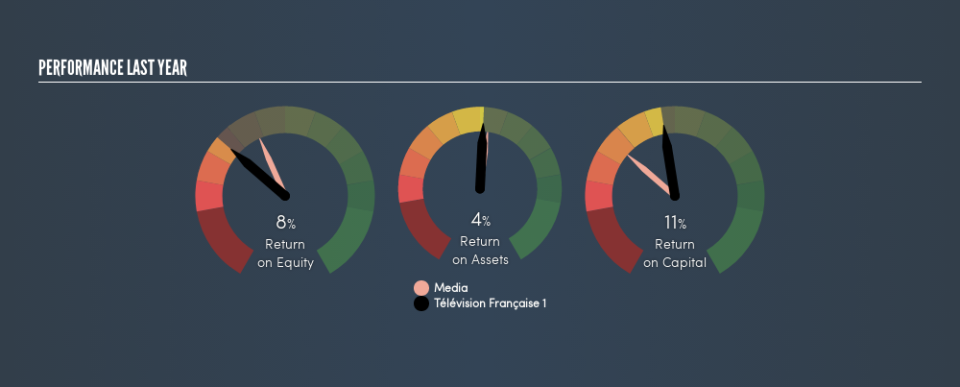Do You Know About Télévision Française 1 SA’s (EPA:TFI) ROCE?

Today we are going to look at Télévision Française 1 SA (EPA:TFI) to see whether it might be an attractive investment prospect. Specifically, we’ll consider its Return On Capital Employed (ROCE), since that will give us an insight into how efficiently the business can generate profits from the capital it requires.
First up, we’ll look at what ROCE is and how we calculate it. Then we’ll compare its ROCE to similar companies. Finally, we’ll look at how its current liabilities affect its ROCE.
Return On Capital Employed (ROCE): What is it?
ROCE measures the ‘return’ (pre-tax profit) a company generates from capital employed in its business. All else being equal, a better business will have a higher ROCE. Overall, it is a valuable metric that has its flaws. Author Edwin Whiting says to be careful when comparing the ROCE of different businesses, since ‘No two businesses are exactly alike.’
How Do You Calculate Return On Capital Employed?
The formula for calculating the return on capital employed is:
Return on Capital Employed = Earnings Before Interest and Tax (EBIT) ÷ (Total Assets – Current Liabilities)
Or for Télévision Française 1:
0.11 = €196m ÷ (€3.2b – €1.4b) (Based on the trailing twelve months to December 2018.)
Therefore, Télévision Française 1 has an ROCE of 11%.
Check out our latest analysis for Télévision Française 1
Is Télévision Française 1’s ROCE Good?
ROCE is commonly used for comparing the performance of similar businesses. We can see Télévision Française 1’s ROCE is around the 10% average reported by the Media industry. Regardless of where Télévision Française 1 sits next to its industry, its ROCE in absolute terms appears satisfactory, and this company could be worth a closer look.
In our analysis, Télévision Française 1’s ROCE appears to be 11%, compared to 3 years ago, when its ROCE was 6.1%. This makes us wonder if the company is improving.
It is important to remember that ROCE shows past performance, and is not necessarily predictive. ROCE can be misleading for companies in cyclical industries, with returns looking impressive during the boom times, but very weak during the busts. ROCE is, after all, simply a snap shot of a single year. Since the future is so important for investors, you should check out our free report on analyst forecasts for Télévision Française 1.
Télévision Française 1’s Current Liabilities And Their Impact On Its ROCE
Current liabilities are short term bills and invoices that need to be paid in 12 months or less. The ROCE equation subtracts current liabilities from capital employed, so a company with a lot of current liabilities appears to have less capital employed, and a higher ROCE than otherwise. To counteract this, we check if a company has high current liabilities, relative to its total assets.
Télévision Française 1 has total assets of €3.2b and current liabilities of €1.4b. As a result, its current liabilities are equal to approximately 43% of its total assets. Télévision Française 1 has a medium level of current liabilities, which would boost the ROCE.
What We Can Learn From Télévision Française 1’s ROCE
While its ROCE looks good, it’s worth remembering that the current liabilities are making the business look better. But note: Télévision Française 1 may not be the best stock to buy. So take a peek at this free list of interesting companies with strong recent earnings growth (and a P/E ratio below 20).
If you are like me, then you will not want to miss this free list of growing companies that insiders are buying.
We aim to bring you long-term focused research analysis driven by fundamental data. Note that our analysis may not factor in the latest price-sensitive company announcements or qualitative material.
If you spot an error that warrants correction, please contact the editor at editorial-team@simplywallst.com. This article by Simply Wall St is general in nature. It does not constitute a recommendation to buy or sell any stock, and does not take account of your objectives, or your financial situation. Simply Wall St has no position in the stocks mentioned. Thank you for reading.

